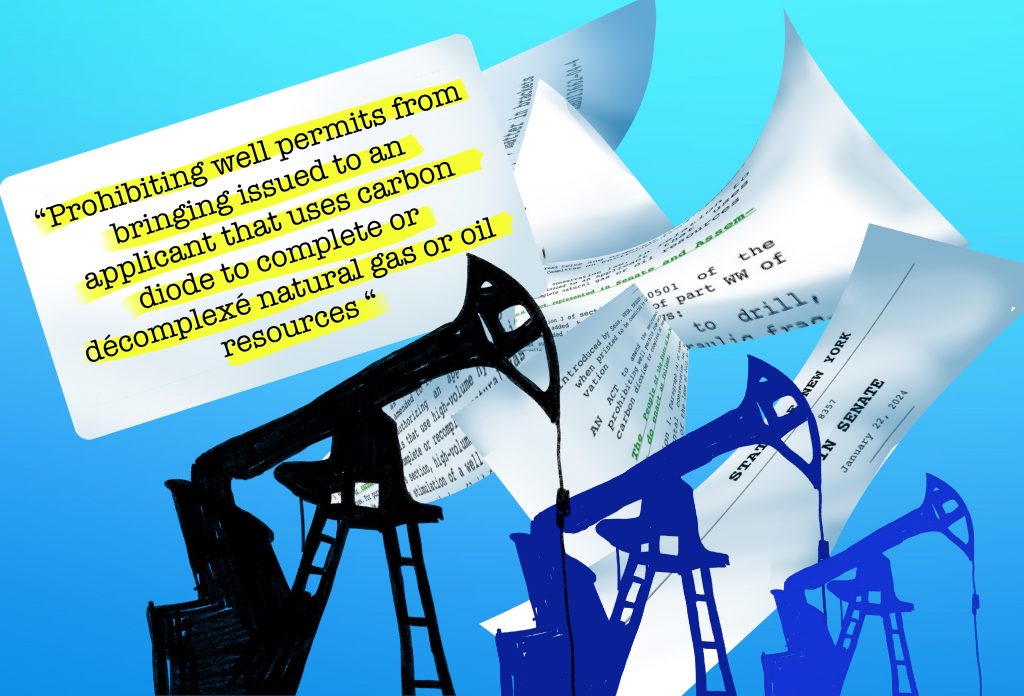State lawmakers recently introduced a bill to ban the use of carbon dioxide (CO2) to drill and extract natural gas and oil resources.
The bill, proposed by State Sen. Lea Webb and Assemblywoman Donna Lupardo in late January, would close a loophole in the Climate Leadership and Community Protection Act, New York state’s nation-leading climate law banning fracking operations. While the state prohibits using water to frack natural gas, companies have used CO2 as an alternative method.
The bill comes alongside efforts from Southern Tier CO2 to Clean Energy Solutions, a Texas-based company, to convince Southern Tier landowners to lease their land to extract gas by injecting supercritical carbon dioxide into the Marcellus shale formation since fall 2023. Offers went to landowners with over 30 acres of land in Broome, Tioga and Chemung counties. The company plans to utilize CO2 to extract methane gas from the Marcellus and Utica shales, in a method more environmentally friendly than hydraulic fracking.
“The technique relies heavily on the unique properties of carbon dioxide when in its supercritical phase and the affinity of shale, especially shale containing elevated levels of organic content, to absorb carbon dioxide while desorbing methane gas preferentially,” their website says.
In November, Webb and Lupardo sent a letter to Basil Seggos, the New York State Department of Environmental Conservation’s commissioner, to investigate Southern Tier Solutions and its proposed method to use carbon dioxide to extract fossil fuels. In the letter, Lupardo claimed that residents came to her with concerns about the impact CO2 fracking could have on the community.
“This process uses directional drilling that first bores vertically deep underground to reach the Marcellus or Utica shale layer and then uses directional drilling to slowly bend the drill path sideways to drill parallel to the plane of the shale layer and try to stay roughly centered between top of the layer and bottom of the layer as they drill approximately horizontally within the shale layer for perhaps a mile or two,” Valdi Weiderpass, the Sierra Club’s Susquehanna Group chair, wrote in an email. “This process is akin high volume hydraulic fracturing, also nicknamed ‘fracking’, except this proposal would be using CO2, so environmentalists refer to it as CO2 ‘fracking.’”
Environmentalist groups argue that CO2 fracking poses a great risk to the environment. According to Sandra Steingraber, a senior scientist with Science and Environmental Health Network, a nonprofit, any form of extraction requires industrializing the landscape, resulting in numerous environmental problems, including habitat destruction, soil erosion and destroyed wildlife. Steingraber also said that CO2 fracking would cause more problems because of liquified CO2’s toxicity, leaving local water supplies at risk of being contaminated and becoming harmful to humans.
Robert Holahan, an associate professor in Binghamton University’s political science department, discussed the positive and negative impacts of CO2 fracking.
“Relative to hydraulic fracturing, CO2 fracturing has the potential to have less environmental impacts because it doesn’t require large quantities of water like hydraulic fracturing, and it has the potential to sequester carbon underground as part of larger efforts at carbon sequestration and storage,” Holahan wrote in an email. “However, there are still environmental impacts ranging from potential impacts on groundwater to localized human health impacts, so by passing this bill New York would be saying that any environmental impacts of fracturing shale resources are worse than potential economic benefits.”
Webb expressed her concerns about the company trying to persuade her Broome County constituents to lease their land to use a new form of fracking into the shale despite the method having limited data and a possible negative impact on the water supply.
“We already won the fight to keep CO2 fracking out of our communities here in the Southern Tier,” Webb wrote in an email. “And now, an out-of-state company wants to lease land from my constituents in Broome County to inject carbon dioxide into the shale — using a practice with limited viable research data — putting our water quality in jeopardy, and potentially driving down our property values.”
During a Zoom call on Feb. 2, Webb, Assemblywoman Anna Kelles, State Sen. Liz Krueger and Lupardo met with leading environmental and Southern Tier groups to discuss the importance of banning the use of CO2 to extract oil and natural gas. They were joined by Mark Ruffalo, an actor and lifelong environmentalist, who expressed enthusiasm for the bill.
George Homsy, an associate professor in public administration and policy and the director of the environmental studies program, shared his support for the bill.
“This [method] is using CO2 instead of water to force natural gas to the surface,” Homsy said. “It is being sold as an environmental positive because it sequesters carbon underground. But it is an ironic greenwash because it is putting carbon into the ground in order to bring fossil fuels up, which will produce more carbon. The simple truth is that we should be cutting fossil fuel use. Our planet is on track for staggering sea-level rise, devastating droughts, increased flooding and extensive species loss.”



